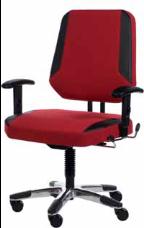Basic HTML Version




Ergonomics
magazine
37
0870 903 9500
6 - 7 M a r c h 2 0 1 2
National Exhibition Centre,
Birmingham
Now in its sixth year, Health andWellbeing at
Work is a leading exhibition and conference for
those responsible for the health and well-being
of workers. In addition to an exhibition with
more than 150 exhibitors, there is an extensive
conference programme where delegates can find
out about a range of topics.
Health andWellbeing at Work attracts people from
the public and private sector and from businesses of all
sizes. At this year’s event, 47% of attendees worked for
small and medium-sized businesses while 40% were
responsible for a workforce of more than 1,000.
www.healthatwork2012.co.uk
and physios think that’s a good thing
but the person at the desk might not be
convinced. For its health benefits, this is
a very interesting product.”
Another seating solution designed to
exercise the sitter’s core muscles is the
Swopper fromVerity Furniture. Balancing
on the stool – which the demonstrator
likened to a fitness ball – requires the
user to make minute adjustments to
their posture even when sitting still. It
also encourages a more upright posture
for improved air flow, while the shape of
the seat opens out the pelvis, which is
claimed to improve circulation.
Verity Furniture expects Swopper to
be used in offices, as well as less formal
surroundings, and offers it on a two-
week trial to enable users to get used
to what for most will be a new style of
sitting. To make the leap less extreme,
Swopper can be specified with a seat
back.
Alternative seating styles are a
specialism of Dutch seating company
Score BV, which has its roots in
industrial and medical seating. Although
it supplies office chairs for people
weighing up to 40 stone in weight – the
Maxx line (available from dealers such as
Posturite and The Osmond Group) – the
company’s main focus is on working
Well sprung: the
Aeris Swopper
A big hit: Score’s
MaXXL range
environments outside the office.
One of its specialities are wheeled
saddle seats for people who have a
need to be seated but mobile within
a fairly small radius, such as dentists
and hairdressers – the castors make it
easy to pull and push oneself around a
working space and because the saddle
forces you to sit with a straight back,
standing up requires very little effort.
Computer breaks
The challenge for employers who
provide staff with appropriate seating
is how to ensure they fulfil their part of
the bargain by improving their working
habits. One option is to install personal
efficiency software that monitors users’
computer activity and prompts them to
take regular breaks and mini-breaks.
This is just what CtrlWORK does. It
combines timed breaks from an existing
task with snippets of information
designed to refresh the user and stave
off mental fatigue. These include hints
on improving computer use, such
as keyboard shortcuts; news flashes;
advice on a healthy lifestyle; and small
commands, known as ‘energisers’, like
‘smile’, ‘look outside the window’ and
‘change position’.
The user remains in control at all
times and can define what information
they want to see during their breaks.
They can also carry on working when a
break is suggested, though the software
will keep a record of such instances and
include them in management reports
that also show how much time the user
has spent on their computer and mouse.
The software was launched 18
months ago and already has 200,000
users in the Netherlands including
office workers at Cap Gemini, which
is conducting a year-long trial into its
effectiveness. In the UK it is available
from Osmond Ergonomics, which is
offering a free trial until December 2012
(www.ergonomics.co.uk).
Diary Date
...continued
continued...

